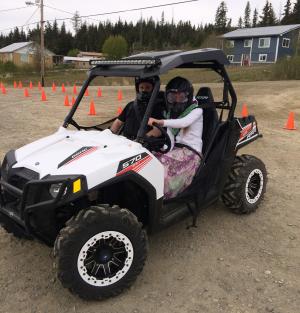-
About Homer
-
- Americans with Disabilities Act Compliance Program City Campgrounds Community Recreation Hickerson Memorial Cemetery
- Library Parks & Trails Public Safety Fire Police Emergency Information
- Events & Activities City Calendar Library Calendar Recreation Calendar Doing Business in Homer Sister City Program Coast Guard City
-
- Departments
- Government
- How Do I?
Project Drive: Putting Youth in the Driver's Seat for Smart Choices Around Drinking & Driving
Five years ago, Homer Police Department personnel saw a ray of hope amidst some tragic statistics. From 2005-2010, of 301 fatal vehicle accidents in Alaska, 89 were alcohol related. In 2005, teen fatalities made up one-fifth of all alcohol related crashes, though licensed teens were only about 6% of the overall licensed population. The ray of hope? 89 of those accidents were preventable.
To prevent future senseless tragedies, Homer Police Department began Project Drive in 2010. Project Drive is an educational clinic that puts youth in the driver’s seat to learn first-hand the effects of drinking and driving in an effort to reduce impaired driving and deter poor decisions by youth to take a ride with someone who has been drinking.
Project Drive started locally with HPD presenting the program to about 100 Homer High School freshmen annually to add a hands-on element to the high school health education curriculum. Using a go-cart that had to be borrowed from the Soldotna Police Department, teens drove around a pre-described course, once to get used to the vehicle and the course, then once again while wearing fatal vision goggles.
It’s not uncommon for the drivers to exhibit a bit of bravado on their first run around the course. Due to the fact that a teen’s prefrontal cortex, or decision-making area of the brain, isn’t fully developed, teens are more likely than older drivers to underestimate dangerous situations or not be able to recognize hazardous situations. This boldness often extends to their thoughts of being capable of driving after drinking. When young people get behind the wheel with the goggles, though, they don't have to imagine and can no longer youthfully overestimate their ability to drive after drinking. The goggles simulate what it’s like to operate with a .08-.10 blood alcohol level, the level at which someone is considered legally impaired. For a further demonstration, youth have the opportunity to try to shoot some hoops with the goggles simulating blood alcohol levels of 0.25!
Afterward, teams discuss their experiences, the physiological effects of alcohol, blood alcohol level to drink equivalency and the legal/risk implications of driving while impaired to reinforce the experiential lesson and challenge them to think about drinking, driving, personal safety, the responsibility of making mature decisions, and the impact their decisions have on family, friends, and many others.

The great success of the Homer High School clinics led HPD to apply to the Alaska Highway Safety Office for funds to acquire their own side-by-side UTV (equipped with kill switches ensure the safety of participants operating them while simulating impairment), a transport trailer and safety equipment to be able to offer program benefits to other schools on the southern Kenai Peninsula. The grant (which included funds to cover personnel’s instructional time) was funded in 2015, allowing HPD to expand the program to include Voznesenka, Razdolna and Ninilchik High Schools.
The popularity of the program has only taken off from there! Outside requests this year to present clinics around the State (one recently completed for the State Youth Court Conference in Anchorage and two upcoming, one for West High School’s Medical Academy in Anchorage and one for a Palmer-Wasilla Town Hall Meeting) has grown the program from an annual 20 hours of instruction reaching 100 students to over 50 hours of instruction reaching approximately 500 students, with Lt. Will Hutt, Sergeant Ryan Browning and Officer Jim Knott presenting. The Alaska Highway Safety Office continues its strong support of the program, granting additional funds to encourage program expansion.
Sgt. Browning is obviously excited about the program. “Not only do we get to show teens first-hand the dangers of driving while impaired while in a safe environment, we get to build positive relationships with the kids and there is no greater measure than that. We believe in this program and its outcome. Our take home message is we know we can’t stop kids from drinking….that’s a choice they will make for themselves at some point in their lives, but what we can do is hit home the message that if they make that choice, to please, please stay out of a vehicle.”

Kudos to Homer Police Department for creating a potentially life-saving program and for their commitment of the extra overtime necessary to share it with our youth. Thanks also to the Alaska Highway Safety Office for their valuable contribution to share the lesson more widely.



